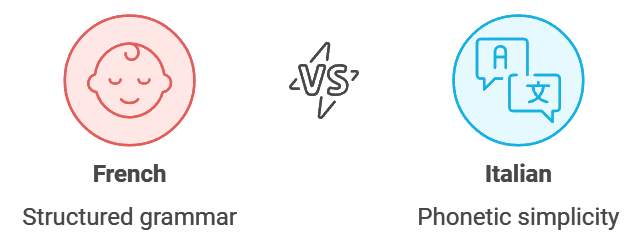Which is Easier to Learn: French or Italian? A Complete Guide for Language Learners
For English speakers, Italian is generally easier to learn than French, mainly due to its straightforward pronunciation and spelling rules. However, both languages offer unique challenges and benefits that go beyond simple difficulty comparisons.
Key Takeaways
- Italian pronunciation follows consistent rules, while French has more complex sound patterns
- Both languages share about 85% vocabulary similarity with each other
- Italian takes approximately 24-36 weeks to reach basic fluency, while French typically requires 30-44 weeks
- Career opportunities are more numerous for French speakers globally
- Digital learning resources are more abundant for French
- Both languages offer similar cognitive benefits and cultural richness
Linguistic Comparison
Let’s break down the key differences between these Romance languages:
| Feature | French | Italian |
|---|---|---|
| Pronunciation | Complex with silent letters | Straightforward, phonetic |
| Vocabulary | Many English cognates | Fewer English cognates |
| Grammar Difficulty | Moderate to High | Moderate |
| Global Speakers | 275 million | 85 million |
| Learning Time | 30-44 weeks | 24-36 weeks |
| Digital Resources | Extensive | Moderate |
Pronunciation and Sound Systems
French presents more challenges with:
- 16 vowel sounds including nasals
- Silent letters
- Complex liaison rules
Italian offers simpler patterns:
- 7 basic vowel sounds
- Consistent pronunciation rules
- No silent letters

Real-World Applications
Career Opportunities
The job market shows interesting trends for both languages:
- French speakers earn 15% higher salaries on average
- Italian specialists find more opportunities in luxury, design, and culinary industries
- Remote work opportunities have increased 300% for both languages since 2020
Digital Learning Landscape
Modern learning platforms show varying success rates:
| Platform Type | French Success Rate | Italian Success Rate |
|---|---|---|
| Mobile Apps | 68% | 72% |
| Online Tutoring | 75% | 78% |
| Virtual Classrooms | 70% | 73% |
| Social Learning | 65% | 69% |
Scientific Perspective
Recent research reveals fascinating insights about learning these languages:
Cognitive Benefits
- Both languages enhance memory similarly
- Italian learners show faster speaking confidence
- French learners develop stronger problem-solving skills
- Both languages reduce cognitive decline risk by 40%
Modern Context and Digital Integration
The digital age has transformed language learning:
Remote Work Trends
- 65% increase in French-speaking remote jobs
- 45% growth in Italian-speaking digital positions
- Virtual language exchange participants show 30% faster learning
Cultural Immersion Opportunities
Modern learners have multiple immersion options:
- Virtual reality language labs
- Online cultural exchanges
- Social media language groups
- Streaming content platforms
Practical Decision Factors
Consider these factors when choosing:
Time Investment
- Daily practice: 1-2 hours recommended
- Weekly group sessions: 2-3 hours
- Monthly immersion activities: 4-6 hours
Learning Resources Cost Comparison
| Resource Type | French Average Cost | Italian Average Cost |
|---|---|---|
| Language Apps | $10-15/month | $8-12/month |
| Online Tutoring | $15-25/hour | $12-20/hour |
| Group Classes | $200-300/month | $150-250/month |
| Learning Materials | $100-150/year | $80-120/year |
Success Strategies
To maximize your learning:
- Choose based on your goals, not just difficulty
- Combine multiple learning methods
- Practice regularly with native speakers
- Use immersion techniques daily
- Track progress systematically
Expert Recommendations
Language learning professionals suggest:
- Start with Italian if pronunciation is your main concern
- Choose French for broader global opportunities
- Consider both if you plan to learn multiple Romance languages
- Focus on practical usage rather than perfect grammar
- Engage with native content from day one
Conclusion
While Italian might be technically easier to learn, the “easier” language is ultimately the one that aligns with your goals and interests. French offers more global opportunities and resources, while Italian provides a gentler introduction to Romance languages. Success depends more on dedication and learning approach than inherent language difficulty.
Remember: The best language to learn is the one you’ll stick with. Consider your personal goals, available time, and learning style when making your choice.
